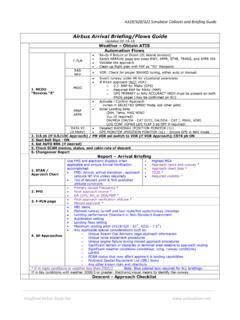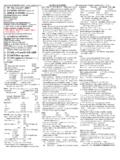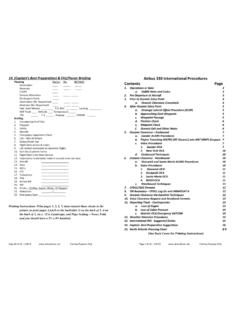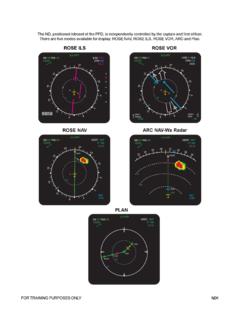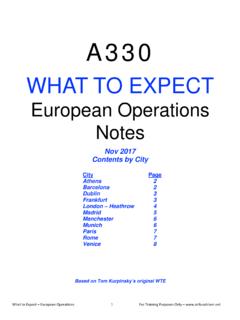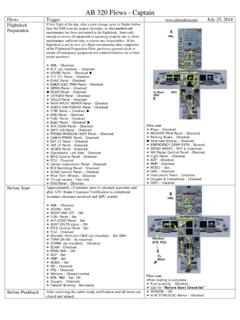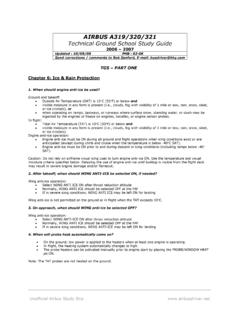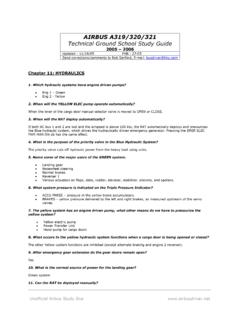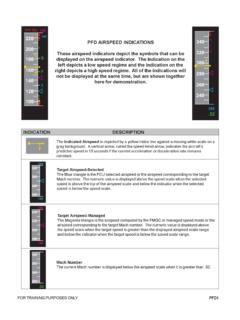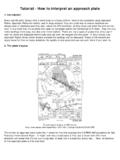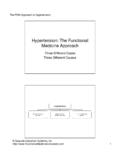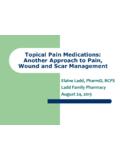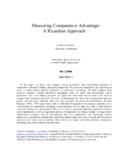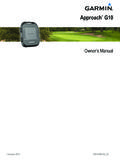Transcription of - A 330 Approach Briefing/Flows Guide – …
1 - A 330 Approach Briefing/Flows Guide 7/21/2018. W Weather Obtain ATIS. Automation flows MCDU Reverse Z . Re-do if Return (auto if EOSID) or Divert (2L lateral revision). Select ARRIVAL page and enter RWY, APPR, STAR, TRANS, and APPR. F-PLN. VIA (Access by lateral revision at destination). On vectors, clean up flight plan(Direct, radial in),FAF as TO Waypoint RAD. VOR: Check for proper NAVAID tuning, either auto or manual. NAV. Insert runway under 4R for situational awareness (technique). 1. MCDU Check navigation accuracy If RNAV Approach (NOT VOR): PROG. o GPS PRIMARY or NAV ACCURACY HIGH must be present on both PROG pages (may be confirmed on ND). PROG PERF. o Set .3 RNP. A F- RAD Activate / Confirm Approach PLN NAV (when in SELECTED SPEED Mode, technique - ask other pilot). Enter Landing Data PERF. QNH, Temp, MAG WIND. APPR. VAPP (if required). DH/MDA (DH/DA - CAT II/III, DA/DDA - CAT I, RNAV, VOR). LDG CONF. PERF. GO- Leave default values unchanged AROUND. 2.
2 ILS pb (if ILS Approach ) / PM VOR sel switch to VOR (if VOR Approach ). 3. Seat Belt Sign ON (Descending through 18,000' Flow). 4. Set AUTO BRK (if desired). 5. Check ECAM STATUS. 6. Check GW < MLW and landing performance Report Brief Approach Relevant threats/concerns Highest MSA. Approach name and runway *. 1. Approach Chart Approach chart date *. TDZE *. Required visibility *. Primary navaid Frequency *. 2. PFD Final Approach course *. DA (DH), AH, or DDA/MAP *. Final Approach verification altitude *. 3. F-PLN page Missed Approach *. MEL items Planned runway turnoff and taxi route Landing performance Standard Assesment? R Autobrake setting Landing flap setting Any applicable special considerations such as: o Unique airport advisory Approach information 4. All Approaches o Unique noise abatement procedures o Unique engine failure during missed Approach procedures o Significant terrain or obstacles in terminal area relative to Approach routing o Significant weather conditions (windshear, icing, runway conditions).
3 O LAHSO. o ECAM status that may affect Approach & landing capabilities o Any other known risks and intentions * If in night conditions or weather less than 2000/3 Note: Blue colored text required for ALL briefings. If in day conditions with weather 2000/3 or greater: State the electronic or visual means to identify the landing runway in the following order of priority: ILS or FMS LNAV/VNAV approaches Other non precision approaches VASI/PAPI or visual reference D Descent - Approach Checklist _____. Unofficial Airbus Study Site Sep 2017 A330 Callouts Takeoff to Flap Retraction Trigger PF PM. Advance thrust levers to approximately EPR. Advance thrust levers to FLX or TOGA. Commencing takeoff roll Check MAN FLX or MAN TOGA on FMA. FLEX or TOGA Verify takeoff thrust on E/WD. FLEX SET or TOGA SET . Captain assumes/maintains control of thrust levers 80 . 80 kts Check STBY airspeed CHECKED . V1 . V1. Captain removes hand from thrust levers ROTATE . VR. Rotate at 3 / sec to 15.
4 Verify positive rate of climb on VSI. POSITIVE RATE . Verify positive rate of climb After liftoff GEAR UP . Maintain F/D commanded attitude Establish initial climb speed of not less GEAR UP . than V2 + 10 knots Position gear lever UP. Monitor speed and altitude AUTOPILOT 1 or Above 100' AFL. AUTOPILOT 2 , as appropriate Select autopilot ON, if requested Select/Request HEADING ___ if At or above 400' AFL. appropriate Select HDG, if requested Move thrust levers to the CL detent At the THR RED ALT CLIMB . LVR CLB flashing Verify CLB annunciations on FMA. CLIMB SET . Normal Climb Profile (NADP 2). Noise Abatement Profile (NADP. When LVR CLB flashes (1000 feet), select 1). When LVR CLB flashes (1,500. CL thrust and adjust the pitch attitude to feet), select CL thrust and follow the maintain a climb rate while accelerating to F/D commands to maintain V2 + 10. 250 KIAS. Retract the flaps at the to 15 knots until 3000 feet AFL (see appropriate F or S speed. special nation state procedures), then adjust the pitch attitude to maintain a slight climb rate while accelerating.
5 At ACCEL ALT (SRS changes to Follow F/D commands to reduce pitch CLB or OP CLB ) and accelerate Check airspeed F speed FLAPS 1 , (if appropriate) Check airspeed (only displayed when FLAPS 2 or FLAPS 1 , if requested 3 were used for takeoff) Select FLAPS 1, if requested Check airspeed FLAPS UP, Check airspeed AFTER TAKEOFF CHECKLIST FLAPS UP . S speed Monitor acceleration to appropriate Select FLAPS 0. speed Disarm spoilers Accomplish After Takeoff Flow and Checklist _____. Unofficial Airbus Study Site Sep 2017 Loss of Thrust At or Above V1. Trigger PF PM. Pilot first recognizing engine failure ENGINE FAILURE . MY AIRCRAFT . Loss of thrust TOGA , if desired Ensure thrust levers at TOGA, if Advance thrust levers to TOGA, if requested desired TOGA SET , if requested ROTATE . VR. Rotate at 3 / sec to . Verify positive rate of climb on VSI. Verify positive rate of climb POSITIVE RATE . After liftoff GEAR UP . Maintain F/D commanded attitude GEAR UP . Trim rudder to maintain a Position gear lever UP.
6 Centered target Monitor speed and altitude AUTOPILOT 1 or Above 100' AFL. AUTOPILOT 2 , as appropriate Select autopilot ON, as requested Comply with runway specific Engine Failure - Takeoff procedure (if published), otherwise, fly runway heading At or above 400' AFL. Select/request (or altitude as specified on HEADING ___ or Select runway heading, engine applicable route manual Engine NAV for EOSID, as appropriate failure heading, or NAV, if Failure Takeoff procedure). requested Advise ATC, when able Push ALT pb or request Climbing through Engine Out ALTITUDE HOLD Push ALT pb, if altitude hold Acceleration Altitude requested Verify level off Check airspeed F speed FLAPS 1 , if appropriate Check airspeed (only displayed when FLAPS 2 or 3 FLAPS 1 , if requested were used for takeoff) Select FLAPS 1, if requested Check airspeed FLAPS UP Check airspeed S speed FLAPS UP . Monitor acceleration to green dot Select FLAPS 0. speed Disarm spoilers Select/request OPEN CLIMB , if desired Select Open Climb, if requested Select/request SPEED ___ , Select green dot speed, if Maintain green dot speed requested Select MCT, if thrust levers are at Green dot speed (VFTO).
7 FLX/MCT, move lever to CL, then Verify thrust levers at MCT. back to MCT MCT SET . MCT . Accomplish ECAM and/or Non-Normal procedure(s) as appropriate _____. Unofficial Airbus Study Site Sep 2017 Rejected Takeoff Capt FO. REJECT, MY AIRCRAFT YOUR AIRCRAFT . Retard thrust levers to IDLE. Use Autobrakes MAX or maximum manual braking Monitor autobrakes Select and maintain maximum reverse thrust until it can be NO AUTOBRAKES , if applicable assured the aircraft can stop on the runway1 Monitor deceleration throughout reject Notify tower, when able Maintain slight forward pressure on sidestick 80 . As soon as aircraft is stopped 60 . After immediately evaluating situation . o Make a PA announcement . THIS IS THE CAPTAIN, REMAIN SEATED, REMAIN SEATED, REMAIN SEATED . o Advise cabin of intentions when able Or Call for and accomplish QRH Evacuation checklist (back cover) Accomplish QRH Evacuation checklist (back cover), if directed Check brake temperature indication 1. In case of complete loss of braking, accomplish Loss of Braking procedure in OM I, NOTE: Autobrakes will not activate below 72 knots.
8 Loss of Braking Procedure IF AUTOBRAKE IS SELECTED: 1. BRAKE PEDALS PRESS. IF NO BRAKNG AVAILABLE: 1. REV MAX. 2. BRAKE PEDALS RELEASE. Brake pedals should be released when the A/SKID & N/W STRG selector is switched OFF, since pedal force produces more braking action in alternate mode than in normal mode. 3. A/SKID & N/W STRG OFF. 4. BRAKE PEDALS PRESS. Apply brakes with care since initial pedal force or displacement produces more braking action in alternate mode than in normal mode. 5. MAX BRK PR 1000 PSI. Monitor brake pressure on BRAKES PRESS indicator. Limit brake pressure to approximately 1000 psi and at low ground speed adjust brake pressure as required. IF STILL NO BRAKING: 1. PARKING BRAKE SHORT AND SUCCESSIVE APPLICATION. Use short and successive brake applications to stop the aircraft. Brake onset asymmetry may be felt at each parking brake application. If possible delay use of parking brake until low speed to reduce the risk of tire burst and lateral control difficulties.
9 _____. Unofficial Airbus Study Site Sep 2017 ILS CAT I. Trigger PF PM. Prior to starting the Ensure waypoints are sequenced properly Approach Confirm the Approach phase has been activated Check airspeed (below VFE Next- 10 knots and not accelerating) Check airspeed (below VFE Next-10 knots FLAPS 1 and not accelerating). FLAPS 1 . Verify S speed Select FLAPS 1. Initial Approach Check airspeed below VFE Next- 10 knots and not accelerating Check airspeed below VFE Next-10 knots (205 max) and not accelerating (205 max). FLAPS 2 FLAPS 2 . Select FLAPS 2. Verify F speed Select APPR on FCU (Check LOC identifier on PFD. Cleared for the Approach Verify both AP1 and AP2 engaged, if an autopilot Approach Verify GS and LOC annunciate blue on FMA. Verify LOC deviation display COURSE ALIVE . LOC alive Verify LOC* annunciates green on FMA. G/S alive Verify G/S Deviation Display GLIDESLOPE ALIVE . Check airspeed 1 dots GEAR DOWN Check airspeed or GEAR DOWN . 3 nm from FAVA Position gear lever DOWN.)
10 Check Triple Indicator Check airspeed dot FLAPS 3, LANDING CHECKLIST Check airspeed or Spoilers Arm FLAPS 3 . 2 nm from FAVA Select FLAPS 3. Accomplish Landing Checklist Check airspeed FLAPS FULL , (if desired) Check airspeed 2 FLAPS FULL , if requested On GS Select FLAPS FULL, if requested Or E Complete Landing Checklist 1 nm from FAVA N Monitor speed G Verify GS annunciates green on FMA. SET MISSED Approach . ALTITUDE Set missed Approach altitude on FCU. 1 Verify GS annunciates green on FMA. SET MISSED Approach Set missed Approach altitude on FCU. E ALTITUDE . N. G. Final Approach Verification Verify Final Approach Verification Altitude Altitude Fix 1000 (auto callout). Verify altitude 1,000' RA STABLE . Verify autothrust in SPEED mode 500 (auto callout). Verify altitude, speed, and sink STABLE, TARGET, SINK ___ . 500' RA. rate or STABLE, ____, SINK ____ . _____. Unofficial Airbus Study Site Sep 2017 ILS CAT I (Cont'd). 100 ABOVE 1 (auto callout). Verify altitude Divide time between monitoring 100' above DA(H).
